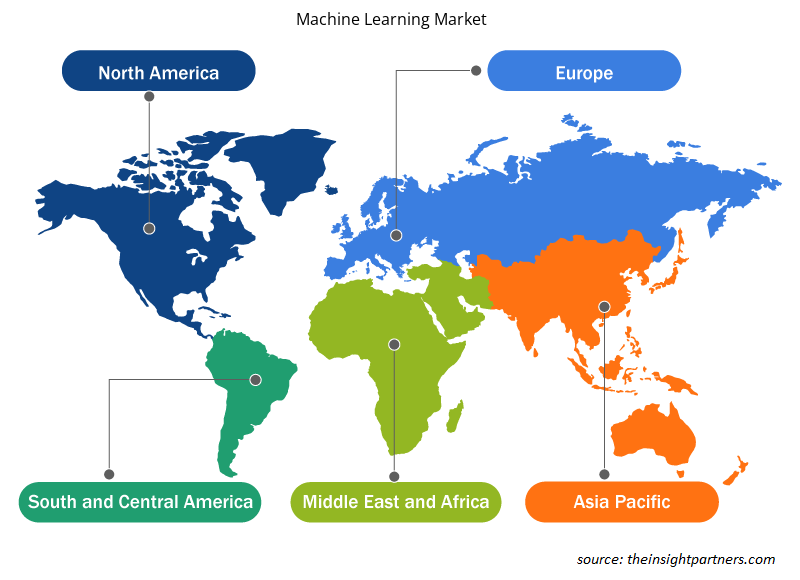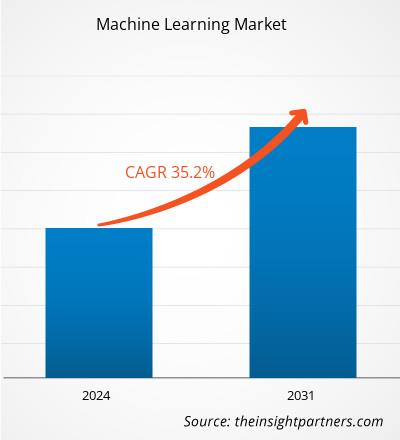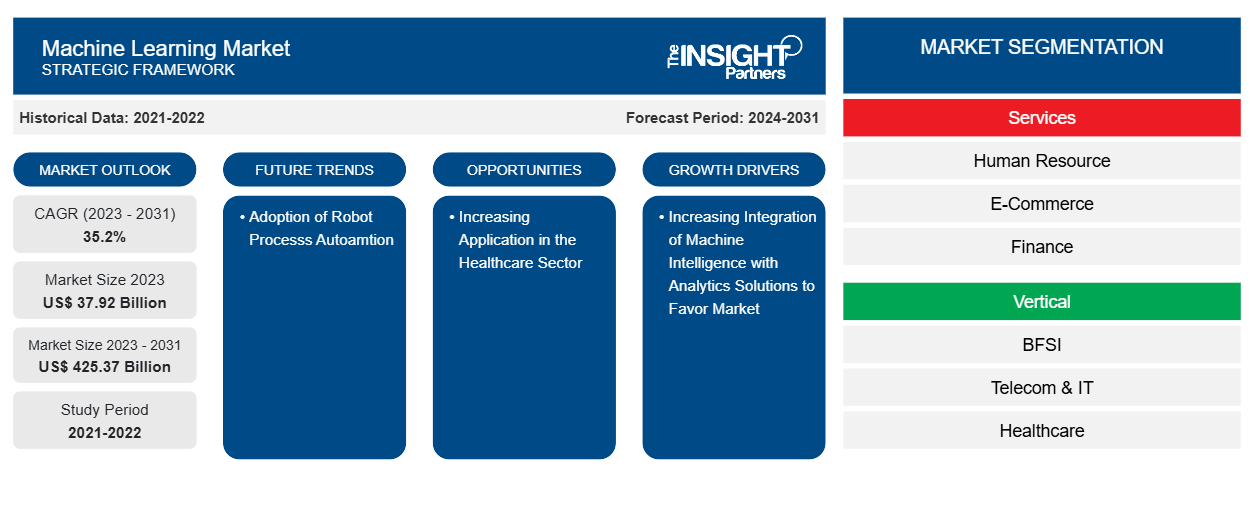Der Markt für maschinelles Lernen soll von 37,92 Milliarden US-Dollar im Jahr 2023 auf 425,37 Milliarden US-Dollar im Jahr 2031 anwachsen. Der Markt soll zwischen 2023 und 2031 eine durchschnittliche jährliche Wachstumsrate (CAGR) von 35,2 % verzeichnen. Die zunehmende Integration maschineller Intelligenz und die zunehmenden Anwendungen im Gesundheitssektor bleiben voraussichtlich weiterhin die wichtigsten Markttrends für maschinelles Lernen.
Marktanalyse für maschinelles Lernen
Das Teilgebiet der Informatik und künstlichen Intelligenz wird als maschinelles Lernen bezeichnet. Um die Genauigkeit zu erhöhen, konzentriert es sich auf Daten und Algorithmen. Die Technologie, die es einem Computer ermöglicht, aus historischen Daten zu lernen, wird als maschinelles Lernen bezeichnet. Algorithmen, die beim maschinellen Lernen verwendet werden, verwenden eine Vielzahl von Techniken, um Wissen aus historischen Daten zu extrahieren. Die Menge und die historischen Daten stehen in direktem Zusammenhang mit den Informationen oder der Datengenauigkeit, und diese Beziehung hilft bei der Entwicklung eines genaueren Modells, das zukünftige Daten vorhersagt.
Marktübersicht für maschinelles Lernen
Aufgrund seiner technologischen Entwicklung ist maschinelles Lernen eine aufstrebende Technologie, die sich täglich ausweitet. Große Datenmengen werden mithilfe maschinellen Lernens entsprechend den organisatorischen Anforderungen verarbeitet. Menschen sind nicht in der Lage, die riesigen Datenmengen zu verarbeiten. Daher werden Computersysteme für die Datenanalyse und -verwaltung benötigt . Maschinelles Lernen ist ein solches Werkzeug. Der Bedarf an technologischen Lösungen zur Verwaltung komplexer Daten und Vorgänge in Unternehmen wird voraussichtlich den Markt für maschinelles Lernen vorantreiben.
Passen Sie diesen Bericht Ihren Anforderungen an
Sie erhalten kostenlos individuelle Anpassungen an jedem Bericht, einschließlich Teilen dieses Berichts oder einer Analyse auf Länderebene, eines Excel-Datenpakets sowie tolle Angebote und Rabatte für Start-ups und Universitäten.
-
Holen Sie sich die wichtigsten Markttrends aus diesem Bericht.Dieses KOSTENLOSE Beispiel umfasst eine Datenanalyse von Markttrends bis hin zu Schätzungen und Prognosen.
Markttreiber und Chancen für maschinelles Lernen
Zunehmende Integration maschineller Intelligenz mit Analyselösungen zur Förderung des Marktes
Die Disziplin der Einzelhandelsanalyse hat in den letzten Jahren erheblich zugenommen. Durch den Einsatz modernster Datenanalysetools konnten zahlreiche E-Commerce-Unternehmen, darunter Alibaba, eBay und Amazon, ihre Umsätze steigern und die Kundenzufriedenheit verbessern. Forschung und Entwicklung in der Sprach- und Stimmerkennungstechnologie haben zur Entstehung ML-basierter kognitiver Sprachcodierungstechniken geführt.
Zunehmende Anwendung im Gesundheitssektor begünstigt den Markt
Zahlreiche Anwendungen im Gesundheitswesen nutzen bereits ML-Technologie. Diese Plattform wertet Millionen einzigartiger Datenpunkte in diesem Industriezweig aus, prognostiziert Ergebnisse und bietet eine präzise Ressourcenzuweisung und schnelle Risikobewertungen.
Die Diagnose und Identifizierung von Krankheiten, die schwierig zu diagnostizieren sind, ist eine der wichtigsten Anwendungen dieser Technologie im Gesundheitswesen. Dazu können mehrere Erbkrankheiten und Krebsarten gehören, die im Frühstadium schwer zu erkennen sind. IBM Watson Genomics ist ein bekanntes Beispiel dafür und zeigt, wie genombasierte Tumorsequenzierung in Verbindung mit kognitivem Computing bei der Krebserkennung helfen kann.
Segmentierungsanalyse des Marktberichts zum maschinellen Lernen
Wichtige Segmente, die zur Ableitung der Marktanalyse für maschinelles Lernen beigetragen haben, sind Dienstleistungen und vertikale Märkte.
- Basierend auf den Dienstleistungen ist der Markt für maschinelles Lernen in Personalwesen, E-Commerce, Finanzen und Buchhaltung, Kundenbetreuung, Vertrieb und Marketing und andere unterteilt. Das Segment Personalwesen dürfte im Prognosezeitraum wachsen.
- Nach Branchen ist der Markt segmentiert in BFSI, Telekommunikation und IT, Gesundheitswesen, Automobil, Fertigung, Lebensmittel und Getränke, Strom und Energie, Unterhaltungselektronik und andere. Das BFSI-Segment dürfte im Prognosezeitraum wachsen.BFSI, telecom & IT, healthcare, automotive, manufacturing, food and beverage, power & energy, consumer electronics, and others. The BFSI segment is anticipated to grow in the forecast period.
Marktanteilsanalyse für maschinelles Lernen nach geografischer Lage
Der geografische Umfang des Berichts zum Markt für maschinelles Lernen ist hauptsächlich in fünf Regionen unterteilt: Nordamerika, Asien-Pazifik, Europa, Naher Osten und Afrika sowie Südamerika/Süd- und Mittelamerika. Nordamerika hat den Markt für maschinelles Lernen dominiert. Trends zur Einführung hoher Technologien in verschiedenen Branchen in der nordamerikanischen Region haben das Wachstum des Marktes für maschinelles Lernen angekurbelt. Faktoren wie die zunehmende Einführung der Digitalisierung und hohe Technologieausgaben von Regierungsbehörden werden voraussichtlich das Wachstum des nordamerikanischen Marktes für maschinelles Lernen vorantreiben. Darüber hinaus zwingt eine starke Betonung von Forschung und Entwicklung in den entwickelten Volkswirtschaften der USA und Kanadas die nordamerikanischen Akteure dazu, technologisch fortschrittliche Lösungen auf den Markt zu bringen. Darüber hinaus gibt es in den USA viele Akteure auf dem Markt für maschinelles Lernen, die sich zunehmend auf die Entwicklung innovativer Lösungen konzentrieren. All diese Faktoren tragen zum Wachstum des Marktes für maschinelles Lernen in der Region bei.
Regionale Einblicke in den Markt für maschinelles Lernen
Die regionalen Trends und Faktoren, die den Markt für maschinelles Lernen im Prognosezeitraum beeinflussen, wurden von den Analysten von Insight Partners ausführlich erläutert. In diesem Abschnitt werden auch die Marktsegmente und die Geografie des Marktes für maschinelles Lernen in Nordamerika, Europa, im asiatisch-pazifischen Raum, im Nahen Osten und Afrika sowie in Süd- und Mittelamerika erörtert.

- Holen Sie sich regionale Daten zum Markt für maschinelles Lernen
Umfang des Marktberichts zum maschinellen Lernen
| Berichtsattribut | Details |
|---|---|
| Marktgröße im Jahr 2023 | 37,92 Milliarden US-Dollar |
| Marktgröße bis 2031 | 425,37 Milliarden US-Dollar |
| Globale CAGR (2023 - 2031) | 35,2 % |
| Historische Daten | 2021-2022 |
| Prognosezeitraum | 2024–2031 |
| Abgedeckte Segmente |
Nach Services
|
| Abgedeckte Regionen und Länder |
Nordamerika
|
| Marktführer und wichtige Unternehmensprofile |
|
Dichte der Marktteilnehmer für maschinelles Lernen: Die Auswirkungen auf die Geschäftsdynamik verstehen
Der Markt für maschinelles Lernen wächst rasant, angetrieben durch die steigende Nachfrage der Endnutzer aufgrund von Faktoren wie sich entwickelnden Verbraucherpräferenzen, technologischen Fortschritten und einem größeren Bewusstsein für die Vorteile des Produkts. Mit steigender Nachfrage erweitern Unternehmen ihr Angebot, entwickeln Innovationen, um die Bedürfnisse der Verbraucher zu erfüllen, und nutzen neue Trends, was das Marktwachstum weiter ankurbelt.
Die Marktteilnehmerdichte bezieht sich auf die Verteilung von Firmen oder Unternehmen, die in einem bestimmten Markt oder einer bestimmten Branche tätig sind. Sie gibt an, wie viele Wettbewerber (Marktteilnehmer) in einem bestimmten Marktraum im Verhältnis zu seiner Größe oder seinem gesamten Marktwert präsent sind.
Die wichtigsten Unternehmen auf dem Markt für maschinelles Lernen sind:
- Amazon Web Services, Inc.
- FICO
- Hewlett Packard Enterprise Development LP
- IBM
- Microsoft
Haftungsausschluss : Die oben aufgeführten Unternehmen sind nicht in einer bestimmten Reihenfolge aufgeführt.

- Überblick über die wichtigsten Akteure auf dem Markt für maschinelles Lernen
Neuigkeiten und aktuelle Entwicklungen zum Markt für maschinelles Lernen
Der Markt für maschinelles Lernen wird durch die Erfassung qualitativer und quantitativer Daten nach Primär- und Sekundärforschung bewertet, die wichtige Unternehmensveröffentlichungen, Verbandsdaten und Datenbanken umfasst. Im Folgenden finden Sie eine Liste der Entwicklungen auf dem Markt:
- Im Februar 2024 gibt XTX Markets, eines der führenden Unternehmen für algorithmischen Handel, mit großer Freude die Gründung von XTY Labs bekannt, einer neuen Abteilung für maschinelles Lernen, die vom neu ernannten Forschungsleiter Dr. Atlas Wang geleitet wird.
(Quelle: XTX Markets, Pressemitteilung, 2024)
- Im April 2024 gaben AdTheorent Holding Company, Inc., einer der Pioniere des maschinellen Lernens, der datenschutzorientierte Lösungen nutzt, um programmatischen Werbetreibenden einen messbaren Mehrwert zu bieten, und Miles Partnership, ein strategisches Marketingunternehmen, das sich ausschließlich auf Reisen und Tourismus konzentriert, die Kampagnenergebnisse der digitalen Werbekampagne VISIT FLORIDA Sun Seekers bekannt.
(Quelle: AdTheorent Holding Company, Inc., Pressemitteilung, 2022)
Marktbericht zum maschinellen Lernen – Abdeckung und Ergebnisse
Der Bericht „Marktgröße und Prognose für maschinelles Lernen (2021–2031)“ bietet eine detaillierte Analyse des Marktes, die die folgenden Bereiche abdeckt:
- Marktgröße und Prognose auf globaler, regionaler und Länderebene für alle abgedeckten wichtigen Marktsegmente.
- Marktdynamik wie Treiber, Beschränkungen und wichtige Chancen
- Wichtige Zukunftstrends
- Detaillierte PEST/Porters Five Forces- und SWOT-Analyse
- Globale und regionale Marktanalyse, die wichtige Markttrends, wichtige Akteure, Vorschriften und aktuelle Marktentwicklungen abdeckt.
- Branchenlandschaft und Wettbewerbsanalyse, einschließlich Marktkonzentration, Heatmap-Analyse, prominenten Akteuren und aktuellen Entwicklungen.
- Detaillierte Firmenprofile
- Historische Analyse (2 Jahre), Basisjahr, Prognose (7 Jahre) mit CAGR
- PEST- und SWOT-Analyse
- Marktgröße Wert/Volumen – Global, Regional, Land
- Branchen- und Wettbewerbslandschaft
- Excel-Datensatz
Aktuelle Berichte
Verwandte Berichte
Erfahrungsberichte
Grund zum Kauf
- Fundierte Entscheidungsfindung
- Marktdynamik verstehen
- Wettbewerbsanalyse
- Kundeneinblicke
- Marktprognosen
- Risikominimierung
- Strategische Planung
- Investitionsbegründung
- Identifizierung neuer Märkte
- Verbesserung von Marketingstrategien
- Steigerung der Betriebseffizienz
- Anpassung an regulatorische Trends























 Kostenlose Probe anfordern für - Markt für maschinelles Lernen
Kostenlose Probe anfordern für - Markt für maschinelles Lernen